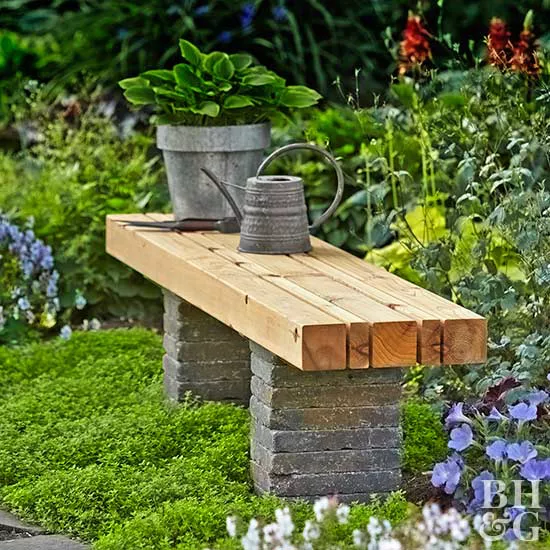- Working Time: 3 hours
- Total Time: 4 hours
- Skill Level: Intermediate
The straight lines of a modern bench make a great foil for a garden's many textures. Visual appeal aside, this simple seat creates a comfortable spot to contemplate the trees and flowers and other garden attractions. Made from the union of standard lumber and concrete paving stones, both readily available materials, this streamlined bench will stand solidly long after the flowers have faded. With this easy step-by-step guide, you'll have a sturdy bench in your garden for years to come!
What You'll Need
Equipment / Tools
- Circular saw
- Drill
- Shovel
- Level
Materials
- 3 5-foot cedar 4 x 4s
- 2 5-foot cedar 2 x 4s
- 4 1-foot cedar 2 x 2s
- Sandpaper
- 16 7 x 10-1/2-inch paver stones
- 3-inch decking screws
- Teak oil finish
- Pea gravel
- Landscape adhesive
Instructions
-
Cut Cedar
Using a circular saw, cut the 4 x 4s and 2 x 4s so the ends line up. Angle the ends of the 2 x 2s if desired along the other cuts. After cutting, make sure to sand the ends and tops of the wood.
Related: How to Use a Circular Saw
-
Create Bracket
Arrange the 4 x 4s and 2 x 4s in an alternating pattern with 1/2 inch of space between them. To create a bracket for the base, set two pavers on the bottom of the bench, 10 inches from each edge, and place the 2 x 2s on either side of a paver. Remove the pavers and secure the 2 x 2s with deck screws. Apply teak oil to protect all wood surfaces and let dry.
Editor's Tip: Use a 1/2-inch-wide scrap of wood as a spacer between pieces.
-
Dig Holes
Dig two holes with a shovel about 21 inches apart. Make sure to use the bracketed spaces on the bottom of the bench as a guide. The holes should be 4 inches deep and slightly larger than a paver.
-
Fill Hole with Pea Gravel
Fill each hole with 3 inches of pea gravel and tamp down firmly. Place the paver on top of the pea gravel. This will give your bench support and prevent it sinking into the ground.
-
Level It Out
After placing the paver on top of the gravel, level it to ground height. Repeat this step with the second side, checking to make sure they are both level. If they are not level, remove a paver to dig deeper, or add in some extra pea gravel.
-
Stack Pavers and Place Bench
Stack the pavers, using adhesive between layers, until you have eight on each side. Set the bench seat over the bases, fitting the brackets snugly on either side of the top paver. Secure the seat to the bases with landscaping adhesive.
Editor's Tip: If you buy your lumber at a large home improvement center, a staff person can cut the wood to the size you need.




















